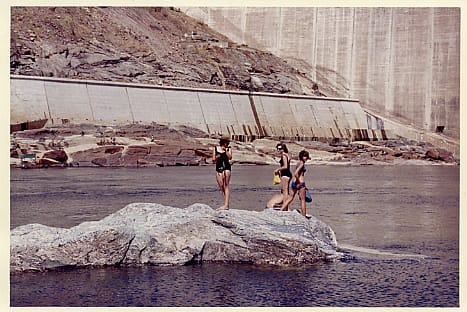An Epic Engineering Feat

Kariba below the dam wall. Me in the foreground, along with Val and Barbara Atkinson fishing Southern Rhodesia 1964
An Epic Engineering Feat
The Federation of Rhodesia and Nyasaland, formed in 1953, was a grand compromise, since amalgamation of the two Rhodesias was not politically possible. A decision was made to build the largest dam in the world on the Zambezi River, which Northern and Southern Rhodesia shared.
An Epic Engineering Feat
Que Que had grand ideas too. It had even proposed itself as the new Southern Rhodesian capital when the Federation was formed. It was slated to become the industrial hub of Southern Rhodesia. It was in the geographical heart of the country. It had grown out of the richest gold mine in the world. But more importantly, for the future, it had iron and limestone deposits side by side. It had prepared itself to woo secondary steel industries. By the mid 1950’s they were starting up.
Kariba Gorge was chosen as the site for the dam wall. Nobody had ever heard of it. It had a big rock jutting out into the narrow gorge sacred to the Batonka people. It was the remotest part of the Federation on Africa’s 4th largest river.
Rhodes’ Great North Road and Railway line had spanned the chasm over the gorge at the Victoria Falls, over two hundred miles upstream, in 1905: also a notable engineering feat. There was only one other bridge that crossed the river, at Chirundu, in its 800 mile journey from there to the sea.
The Roads Department said it could not build a road to Kariba Gorge quickly or cheaply. The Irrigation Department did, by following the elephant trails.
Construction of the dam began in August 1955 with the diversion works by Impresit, an Italian firm. Dad knew first hand the Italians were first class road and bridge builders, having seen the work of the Italian Fascists during WWII in Abyssinia. They were not much good as an imperial power but you had to give credit where it was due!
The 57,000 Batonga people, however, most of whom had never seen a white man, thought otherwise. Nyaminyami, the river god, would be angry.
On completion of the dam their sacred rock would be one hundred feet beneath the surface of the water. They were angry too at being resettled.
In 1957 floods burst through the coffer dam. The suspension footbridge and road bridge were also swept away.
Dad was gone four days a week to Salisbury when Parliament was in session. But on occasion there was a benefit for our family. We got the opportunity to fly over Kariba and see the floods. Air travel was a big deal in those days. I got air sick as the plane banked low in the gorge. I lost my expensive dental braces Dr. Hossell had just fitted, in a sick bag. Still, in between gaging, it was an extraordinary sight.
Unusually high temperatures caused several workers to die of heatstroke. Tools and building equipment would get so hot in the sunshine they had to be carried in buckets of water or hosed down. Eighteen men accidently fell into wet concrete during construction and perished.
The following year, floods again breached the main coffer dam and again took both bridges away.
In all, eighty six men lost their lives in its construction.
Finally, on June 22, 1959 the last skip of concrete was poured. Despite the setbacks the giant wall, 3 million tons of concrete, 420 feet tall and 1,900 feet long was complete. A lake of 2000 sq miles was in the making, the shoreline expanding rapidly, while my teeth straightened out, constrained by their new, unyielding steel bands.
View historic pictures of the building of Kariba made available by Alan Smith on Eddy Norris’ web site:
http://rhodesianheritage.blogspot.com/2011/05/kariba-gorge-scheme.html
